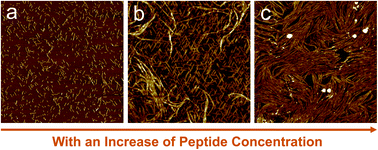Hierarchical ordering of amyloid fibrils on the mica surface†
Abstract
The aggregation of amyloid

* Corresponding authors
a Department of Physics, Ningbo University, Ningbo, China
b
College of Life Sciences, Inner Mongolia Agricultural University, Hohhot, China
E-mail:
Zhangfeng@imau.edu.cn
c Department of Mechanical and Manufacturing Engineering, Aalborg University, Aalborg, Denmark
d
Shanghai Institute of Applied Physics, Chinese Academy of Sciences, Shanghai, China
E-mail:
Zhangyi@sinap.ac.cn
The aggregation of amyloid

 Please wait while we load your content...
Something went wrong. Try again?
Please wait while we load your content...
Something went wrong. Try again?
X. Zhou, Y. Zhang, F. Zhang, S. Pillai, J. Liu, R. Li, B. Dai, B. Li and Y. Zhang, Nanoscale, 2013, 5, 4816 DOI: 10.1039/C3NR00886J
To request permission to reproduce material from this article, please go to the Copyright Clearance Center request page.
If you are an author contributing to an RSC publication, you do not need to request permission provided correct acknowledgement is given.
If you are the author of this article, you do not need to request permission to reproduce figures and diagrams provided correct acknowledgement is given. If you want to reproduce the whole article in a third-party publication (excluding your thesis/dissertation for which permission is not required) please go to the Copyright Clearance Center request page.
Read more about how to correctly acknowledge RSC content.
 Fetching data from CrossRef.
Fetching data from CrossRef.
This may take some time to load.
Loading related content
